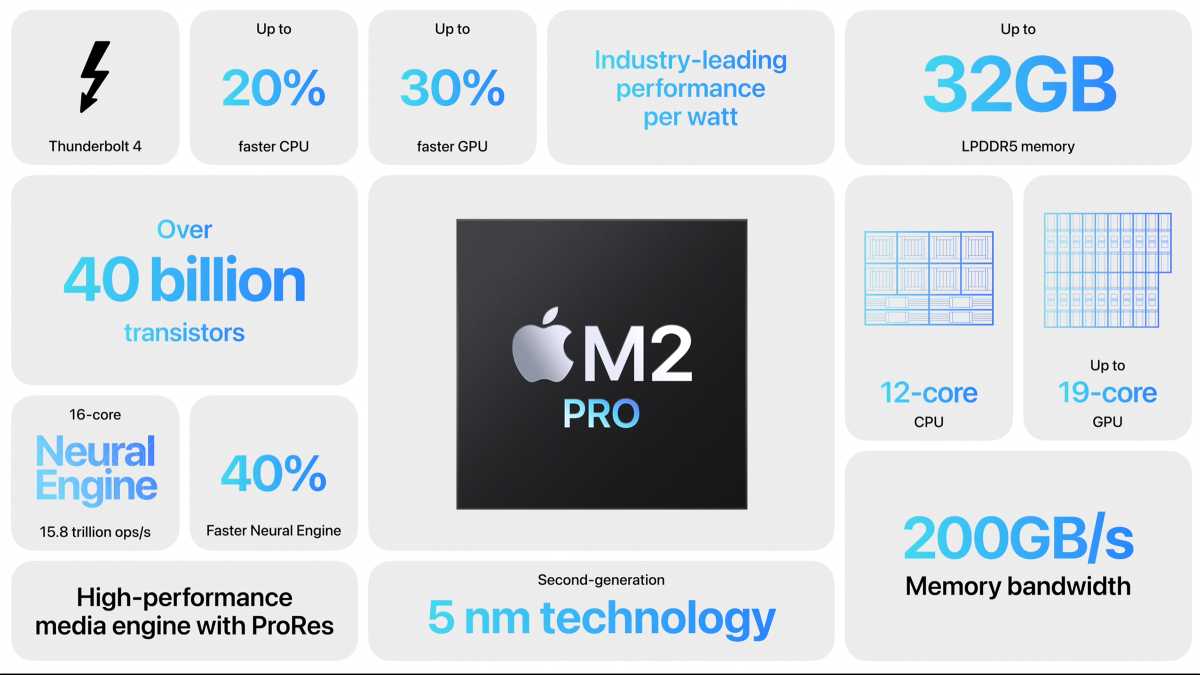Apple’s chip rollout continues on with the introduction of the next generation of M2 processors unveiled in the new 14- and 16-inch MacBook Pro. The new M2 Pro and M2 Max arrive six months after Apple introduced the M2 chip in the MacBook Air and 13-inch MacBook Pro.
“Only Apple is building SoCs like M2 Pro and M2 Max. They deliver incredible pro performance along with industry-leading power efficiency,” said Johny Srouji, Apple’s senior vice president of Hardware Technologies in a press release. “With an even more powerful CPU and GPU, support for a larger unified memory system, and an advanced media engine, M2 Pro and M2 Max represent astonishing advancements in Apple silicon.”
The M2 Pro and M2 Max offer more CPU cores, GPU cores, and memory bandwidth than their predecessors. Let’s take a look at the specifics of the new chips.
M2 Pro: 12-core CPU, 19-core GPU

Apple
The M2 Pro uses a second-generation 5nm process, and offers more CPU and GPU cores, memory bandwidth, and several other upgrades over the M2 and M1 Pro chips. The M2 Pro has 40 billion transitions, which is 20 percent more than the M1 Pro twice the number of the M2. Apple claims that the M2 Pro has a larger L2 cache than the 24MB in the M1 Pro, though it doesn’t provide specifics.
| M1 Pro | M2 | M2 Pro | |
|---|---|---|---|
| CPU cores | 8 or 10 (6/8 performance, 2 efficiency) | 8 (4 performance, 4 efficiency) | 10 or 12 (6/8 performance, 4 efficiency) |
| GPU cores | 14 or 16 | 8 or 10 | 16 or 19 |
| Unified memory | 16GB, 32GB | 8GB, 16GB, 24GB | 16GB, 32GB |
| Memory bandwidth | 200GBps | 100GBps | 200GBps |
| Neural Engine | 16-core | 16-core | 16-core |
Like the M1 Pro, the M2 Pro offers a benefit to video editors with its built-in media engine that accelerates H.264, HEVC, and ProRes video encoding and decoding. It also offers better power efficiency during playback of multiple streams of 4K and 8K ProRes video. And a custom image signal processor works with the Neural Engine to improve the image quality of the built-in 1080p FaceTime camera on the MacBook Pro.
Compared to the M1 Pro, Apple’s benchmarks show that the M2 Pro is 40 percent faster in Adobe Photoshop image processing, and 25 percent faster in Xcode code compiling. Apple also offers comparisons to the Core i9 16-inch MacBook Pro, the last Intel-based laptop; Apple says the M2 Pro is 2.5 times faster in Photoshop and 80 percent faster in Xcode.
M2 Max: 12-core CPU, 38-core GPU

Apple
The M2 Max takes the M2 Pro and goes several steps further, with 67 billion transistors (10 million more than the M1 Max), extra CPU and GPU cores, and more memory bandwidth.
| M1 Max | M2 Max | |
|---|---|---|
| CPU cores | 10 (8 performance, 2 efficiency) | 12 (8 performance, 4 efficiency) |
| GPU cores | 24 or 32 | 30 or 38 |
| Unified memory | 32GB, 64GB | 32GB, 64GB, 96GB |
| Memory bandwidth | 400GBps | 400GBps |
| Neural Engine | 16-core | 16-core |
Apple says the M2 Max is “the world’s most powerful and efficient chip for a pro laptop.” Of note, it has the same media engine as the M2 Pro, but just a single video-encode engine and ProRes engines, where the M1 Max offered two of each. To upgrade to 96GB of memory, you’ll need a MacBook with a 38-core GPU, which costs $3,099 (14-inch) or $3,499 (16-inch), with an extra $800 for the memory upgrade over 32GB.
In Apple’s benchmarks, the M2 Max touts a 30 percent improvement over the M1 Max using color grading in DaVinci Resolve; in the same test, the M2 Max is 2 times faster than the Intel Core i9 MacBook Pro. With effects rendering in Cinema 4D, the M2 Max is 30 percent faster than the M1 Max, and 6 times faster than the Core i9 MacBook Pro.